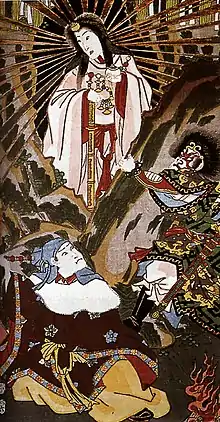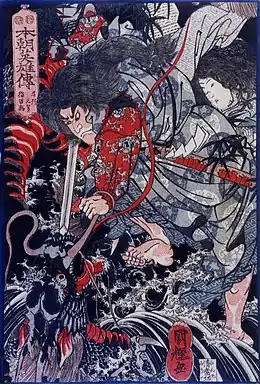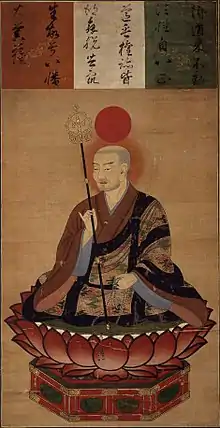Takenouchi no Sukune 武内宿禰 | |
|---|---|
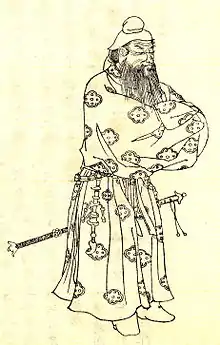 Takenouchi no Sukune drawn by Kikuchi Yosai | |
| Ōomi | |
| Personal details | |
| Born | 84 AD |
| Died | Unknown |
| Children |
|
| Parent |
|
Takenouchi no Sukune (武内宿禰) or Takeshiuchi no Sukune was a legendary Japanese hero-statesman of the 1st century, and a Shinto kami.
He is recorded in Japan's earliest literary texts, the Kojiki (ca. 712) and the Nihon Shoki (720).
Life
Takenouchi no Sukune was supposedly the son of Princess Kagehime, and is said to be grandson to Prince Hikofutsuoshinomakoto (彦太忍信命). Descended from Emperor Kōgen, Takenouchi no Sukune served under five legendary emperors, Emperor Keikō, Emperor Seimu, Emperor Chūai, Emperor Ōjin, and Emperor Nintoku, but was perhaps best known for his service as Grand Minister (Ōomi) to the Regent Empress Jingū, with whom he supposedly invaded Korea. While Jingu was regent to her son, Ojin, Takenouchi was accused of treason. He underwent the "ordeal of boiling water" as a way to prove his innocence.
In addition to his martial services to these emperors, he was reputedly also a saniwa, or spirit medium.
He is said to have been the grandson of HIkofutsuoshinomakoto in the Nihon Shoki, where as the Kojiki states that he was the son of Hikofutsuoshinomakoto.[1]
Legacy
Twenty-eight Japanese clans are said to be descended from Takenouchi no Sukune, including Takeuchi and Soga. He is a legendary figure, and is said to have drunk daily from a sacred well, which helped him live to be 280 years old. He is enshrined as a Kami at the Ube shrine, in the Iwami district of the Tottori Prefecture and at local Hachiman shrines.
His portrait has appeared on the Japanese yen, and dolls of him are popular Children's Day gifts.
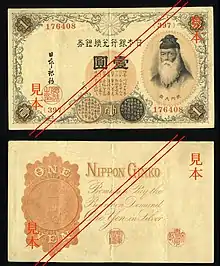
- First convertible silver yen bill (1889-1958)
- First five yen bill (1899-1939)
- Third five yen bill (1916-1939)
- Second one-yen bill (1943-1958)
- Second 200 yen bill (1945-1946)
Family
- Father: Yanushi Otake Ogokoro no Mikoto (屋主忍男武雄心命, ?–?)
- Mother: Yamashita no Kage-hime (影媛), sister of Kiinokuni no Miyatsukuko Uzuhiko (Ujihiko) (山下影日売)
- Wife(s): unknown
- Son: Hata no Yashiro (羽田矢代, ?–?), ancestor of the Hata clan (波多氏).
- Son: Kose no Okara (許勢小柄, ?–?), ancestor of the Kose clan (巨勢氏).
- Son: Soga no Ishikawa (蘇我石川, ?–?), ancestor of the Soga clan (蘇我氏).
- Son: Heguri no Tsuku (平群木菟, ?–?), ancestor of the Heguri clan (平群氏).
- Son: Ki no Tsuno (紀角, ?–?), ancestor of the Ki clan (紀氏).
- Daughter: Kume no Matio-hime (久米能摩伊刀比売, ?–?)
- Daughter: Nonoiro-hime (怒能伊呂比売, ?–?)
- Son: Kazuragi no Sotsuhiko (葛城襲津彦, ?–?), ancestor of the Katsuragi clan (葛城氏).
- Son: Wakugo no Sukune (若子宿禰)
- Wife(s): unknown
Family tree
Artwork
 Empress Jingū (above) and Takenouchi no Sukune (below) Fishing at Chikuzen
Empress Jingū (above) and Takenouchi no Sukune (below) Fishing at Chikuzen
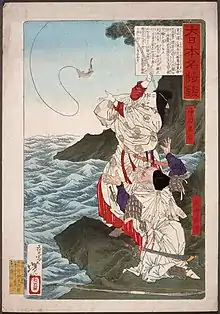 Empress Consort Jingū and Takenouchi fish in Chikuzen.
Empress Consort Jingū and Takenouchi fish in Chikuzen.
Print of Tsukioka Yoshitoshi (1876)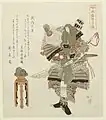 The Regent Takeuchi no Sukune.
The Regent Takeuchi no Sukune.
Print of Totoya Hokkei (1822)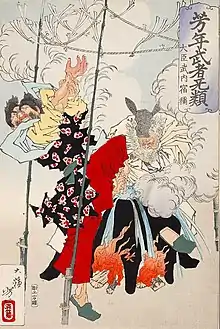 Daijin Takenouchi no Sukune by Tsukioka Yoshitoshi
Daijin Takenouchi no Sukune by Tsukioka Yoshitoshi
External links
- Encyclopedia of Shinto: Biographical note
- Tsukioka Yoshitoshi: Ukiyo-e image (1883)
- Nippon Kindai Banknote:Banknote portrait (1916)
- Takenouchi no Sukune Meets Dragon King of the Sea, Dallas Museum of Art, bronze sculpture:
Notes
- ↑ There are two ways this name is transcribed: "Ika-gashiko-me" is used by Tsutomu Ujiya, while "Ika-shiko-me" is used by William George Aston.[32]
References
- ↑ "Takeuchi no Sukune • . A History . . of Japan . 日本歴史". . A History . . of Japan . 日本歴史. Retrieved 2022-11-02.
- ↑ Philippi, Donald L. (2015). Kojiki. Princeton University Press. pp. 104–112.
- ↑ Atsushi, Kadoya; Tatsuya, Yumiyama (20 October 2005). "Ōkuninushi". Encyclopedia of Shinto. Retrieved 2010-09-29.
- ↑ Herbert, J. (2010). Shinto: At the Fountainhead of Japan. Routledge Library Editions: Japan. Taylor & Francis. p. 402. ISBN 978-1-136-90376-2. Retrieved 2020-11-21.
- ↑ Atsushi, Kadoya (21 April 2005). "Ōnamuchi". Encyclopedia of Shinto. Retrieved 2010-09-29.
- 1 2 The Emperor's Clans: The Way of the Descendants, Aogaki Publishing, 2018.
- 1 2 3 4 5 6 7 8 9 10 Varley, H. Paul. (1980). Jinnō Shōtōki: A Chronicle of Gods and Sovereigns. Columbia University Press. p. 89. ISBN 9780231049405.
- ↑ Atsushi, Kadoya (28 April 2005). "Kotoshironushi". Encyclopedia of Shinto. Retrieved 2010-09-29.
- ↑ Sendai Kuji Hongi, Book 4 (先代舊事本紀 巻第四), in Keizai Zasshisha, ed. (1898). Kokushi-taikei, vol. 7 (国史大系 第7巻). Keizai Zasshisha. pp. 243–244.
- ↑ Chamberlain (1882). Section XXIV.—The Wooing of the Deity-of-Eight-Thousand-Spears.
- ↑ Tanigawa Ken'ichi 『日本の神々 神社と聖地 7 山陰』(新装復刊) 2000年 白水社 ISBN 978-4-560-02507-9
- 1 2 Kazuhiko, Nishioka (26 April 2005). "Isukeyorihime". Encyclopedia of Shinto. Archived from the original on 2023-03-21. Retrieved 2010-09-29.
- 1 2 『神話の中のヒメたち もうひとつの古事記』p94-97「初代皇后は「神の御子」」
- 1 2 日本人名大辞典+Plus, デジタル版. "日子八井命とは". コトバンク (in Japanese). Retrieved 2022-06-01.
- 1 2 ANDASSOVA, Maral (2019). "Emperor Jinmu in the Kojiki". Japan Review (32): 5–16. ISSN 0915-0986. JSTOR 26652947.
- 1 2 "Visit Kusakabeyoshimi Shrine on your trip to Takamori-machi or Japan". trips.klarna.com. Retrieved 2023-03-04.
- 1 2 3 Nussbaum, Louis-Frédéric (2002). Japan Encyclopedia. Harvard University Press. p. 32. ISBN 9780674017535.
- 1 2 3 Ponsonby-Fane, Richard (1959). The Imperial House of Japan. Ponsonby Memorial Society. p. 29 & 418.
- 1 2 3 Brown, Delmer M. and Ichirō Ishida (1979). A Translation and Study of the Gukanshō, an Interpretative History of Japan Written in 1219. University of California Press. p. 251. ISBN 9780520034600.
- ↑ 『図説 歴代天皇紀』p42-43「綏靖天皇」
- 1 2 3 4 5 Anston, p. 144 (Vol. 1)
- ↑ Grapard, Allan G. (2023-04-28). The Protocol of the Gods: A Study of the Kasuga Cult in Japanese History. University of California Press. ISBN 978-0-520-91036-2.
- ↑ Tenri Journal of Religion. Tenri University Press. 1968.
- ↑ Takano, Tomoaki; Uchimura, Hiroaki (2006). History and Festivals of the Aso Shrine. Aso Shrine, Ichinomiya, Aso City.: Aso Shrine.
- ↑ Anston, p. 143 (Vol. 1)
- 1 2 3 4 Anston, p. 144 (Vol. 1)
- ↑ Watase, Masatada (1983). "Kakinomoto no Hitomaro". Nihon Koten Bungaku Daijiten 日本古典文学大辞典 (in Japanese). Vol. 1. Tokyo: Iwanami Shoten. pp. 586–588. OCLC 11917421.
- 1 2 3 Aston, William George. (1896). Nihongi: Chronicles of Japan from the Earliest Times to A.D. 697, Volume 2. The Japan Society London. pp. 150–164. ISBN 9780524053478.
- 1 2 3 "Kuwashi Hime • . A History . . of Japan . 日本歴史". . A History . . of Japan . 日本歴史. Retrieved 2023-11-17.
- 1 2 3 Anston, p. 149 (Vol. 1)
- ↑ Louis-Frédéric, "Kibitsu-hiko no Mikoto" in Japan Encyclopedia, p. 513.
- ↑ Ujiya, Tsutomu (1988). Nihon shoki. Grove Press. p. 121. ISBN 978-0-8021-5058-5.
- ↑ Aston, William George. (1896). Nihongi: Chronicles of Japan from the Earliest Times to A.D. 697, Volume 2. The Japan Society London. p. 109 & 149–150. ISBN 9780524053478.
- 1 2 Asakawa, Kan'ichi (1903). The Early Institutional Life of Japan. Tokyo Shueisha. p. 140. ISBN 9780722225394.
- ↑ Brown, Delmer M. and Ichirō Ishida (1979). A Translation and Study of the Gukanshō, an Interpretative History of Japan Written in 1219. University of California Press. p. 248 & 253. ISBN 9780520034600.
- ↑ Henshall, Kenneth (2013-11-07). Historical Dictionary of Japan to 1945. Scarecrow Press. ISBN 978-0-8108-7872-3.
- ↑ "Mimakihime • . A History . . of Japan . 日本歴史". . A History . . of Japan . 日本歴史. Retrieved 2023-11-18.
- ↑ Brown, Delmer M. and Ichirō Ishida (1979). A Translation and Study of the Gukanshō, an Interpretative History of Japan Written in 1219. University of California Press. p. 248 & 253–254. ISBN 9780520034600.
- 1 2 Henshall, Kenneth (2013-11-07). Historical Dictionary of Japan to 1945. Scarecrow Press. ISBN 978-0-8108-7872-3.
- ↑ "Sahobime • . A History . . of Japan . 日本歴史". . A History . . of Japan . 日本歴史. Retrieved 2023-11-18.
- 1 2 Memoirs of the Research Department of the Toyo Bunko (the Oriental Library), Issues 32-34. Toyo Bunko. 1974. p. 63. Retrieved July 30, 2019.
- 1 2 "Yasakairihime • . A History . . of Japan . 日本歴史". . A History . . of Japan . 日本歴史. Retrieved 2023-11-28.
- 1 2 Kenneth Henshall (2013). Historical Dictionary of Japan to 1945. Scarecrow Press. p. 487. ISBN 9780810878723.
- 1 2 Memoirs of the Research Department of the Toyo Bunko (the Oriental Library), Issues 32-34. Toyo Bunko. 1974. pp. 63–64. Retrieved 1 August 2019.
- ↑ "Saigū | 國學院大學デジタルミュージアム". web.archive.org. 2022-05-22. Retrieved 2023-11-29.
- ↑ Kidder, Jonathan E. (2007). Himiko and Japan's Elusive Chiefdom of Yamatai: Archaeology, History, and Mythology. University of Hawaii Press. p. 344. ISBN 9780824830359.
- 1 2 3 Packard, Jerrold M. (2000). Sons of Heaven: A Portrait of the Japanese Monarchy. FireWord Publishing, Incorporated. p. 45. ISBN 9781930782013.
- 1 2 3 Xinzhong, Yao (2003). Confucianism O - Z. Taylor & Francis US. p. 467. ISBN 9780415306539.
- ↑ Aston, William George. (1998). Nihongi, p. 254–271.
- 1 2 Aston, William. (1998). Nihongi, Vol. 1, pp. 224–253.
- ↑ 文也 (2019-05-26). "仲姫命とはどんな人?". 歴史好きブログ (in Japanese). Retrieved 2023-01-19.
- ↑ 日本人名大辞典+Plus, 朝日日本歴史人物事典,デジタル版. "仲姫命(なかつひめのみこと)とは? 意味や使い方". コトバンク (in Japanese). Retrieved 2023-01-19.
{{cite web}}: CS1 maint: multiple names: authors list (link) - ↑ "Nunasoko Nakatsuhime • . A History . . of Japan . 日本歴史". . A History . . of Japan . 日本歴史. Retrieved 2023-11-18.
- ↑ Aston, William. (1998). Nihongi, Vol. 1, pp. 254–271.
